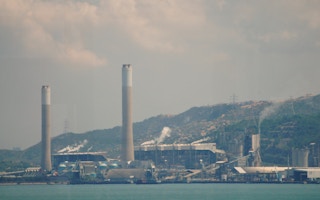Hong Kong-based energy company CLP Holdings will no longer invest in new coal-fired power plants and will progressively phase out all remaining coal assets by 2050.
To continue reading, subscribe to Eco‑Business.
There's something for everyone. We offer a range of subscription plans.
- Access our stories and receive our Insights Weekly newsletter with the free EB Member plan.
- Unlock unlimited access to our content and archive with EB Circle.
- Publish your content with EB Premium.
The move, an effort to combat climate change, was announced on Tuesday under CLP’s updated Climate Vision 2050, which will guide the firm in managing climate-related opportunities and risks in its operations, such as the acquisition or divestment of power assets.
Under its new decarbonisation strategy, CLP has committed to an 80 per cent reduction in the firm’s carbon intensity by 2050, compared with 2007 levels. The firm also aims to increase its clean energy capacity to 30 per cent by 2030, up from 13 per cent last year. As of December 2018, coal made up 51 per cent of CLP’s power generation capacity, with gas comprising 22 per cent.
The holding company for the CLP Group, one of the largest investor-owned energy businesses in Asia Pacific, CLP supplies power to 80 per cent of Hong Kong’s population, but it has in recent years also expanded to invest in power assets in mainland China, India, Southeast Asia, Taiwan and Australia.
According to Julien Vincent, executive director of Australian non-governmental organisation (NGO) Market Forces, which has been campaigning for Asian banks to quit coal, CLP’s decision not to invest in any new coal capacity is set to have ramifications on various projects across the region, as the move means CLP will pull out of all proposed coal-fired power projects it was previously involved in, including Vung Ang 2 and Vinh Tan 3 in Vietnam.
Whether Vung Ang 2 and Vinh Tan 3 will reach completion without CLP’s involvement will depend on the projects’ other sponsors, including Japanese bank Mitsubishi UFJ Financial Group (MUFG) and Singapore-headquartered DBS Bank, both of which announced they would stop financing new coal power earlier this year, Vincent said.
CLP plans to review and strengthen its Climate Vision 2050 targets at least every five years.
Coal’s future looking bleak
Much of Asia, particularly the Association of Southeast Asian Nations (Asean), has traditionally dragged its heels on the shift to clean energy, despite being the most vulnerable region to climate change, and home to the vast majority of the world’s most polluted cities.
Corporate climate action, however, is on the rise in the region. CLP’s move comes on the same day that London and Hong Kong-headquartered Standard Chartered Bank pulled out of three coal-fired power projects in Asean. Earlier this year, Southeast Asia’s biggest banks ceased coal power lending.
Vincent said: “It’s been a pretty exciting year for renewables in the region.”
“The market for new coal power plants is shrinking rapidly. A few years ago, there were 120 gigawatts of proposed coal power in the pipeline. That pipeline has halved and every new decision by a financial, utility or engineering company to shift away from coal makes the remaining pipeline look even more speculative,” he said.
What makes CLP’s announcement stand out, is the fact that it will pull out of the new coal power projects it had already committed to, said Vincent. Such projects would be part of its existing planning portfolio.
Other companies such as Japanese developers Marubeni, Itochu, Sumitomo and Mitsubishi have also pledged not to pursue new coal power plants. But some have left loopholes allowing plenty of scope for policies to be limited in their effectiveness, or even bypassed entirely—for instance, by allowing for targeted exceptions.
CLP’s move, however, still doesn’t go far enough, Vincent observed. Research by Climate Analytics shows coal power must be phased out globally by 2040 to meet the Paris objective of limiting global warming to 1.5 degrees Celsius. That’s 10 years earlier than CLP aims to shut down its last coal-fired power station.
And while it aims to cut carbon intensity—the emissions generated per kilowatt-hour—the reduction in the company’s absolute emissions remains to be seen, Vincent pointed out.
This is because companies can, in theory, bring down their carbon intensity by continuing to acquire assets in less carbon-intensive industries to increase their income, while leaving the absolute emissions largely untouched.
“CLP’s intensity target is only something to be celebrated if it requires the reduction of overall emissions by an amount consistent with the Paris Agreement,” Vincent said.










